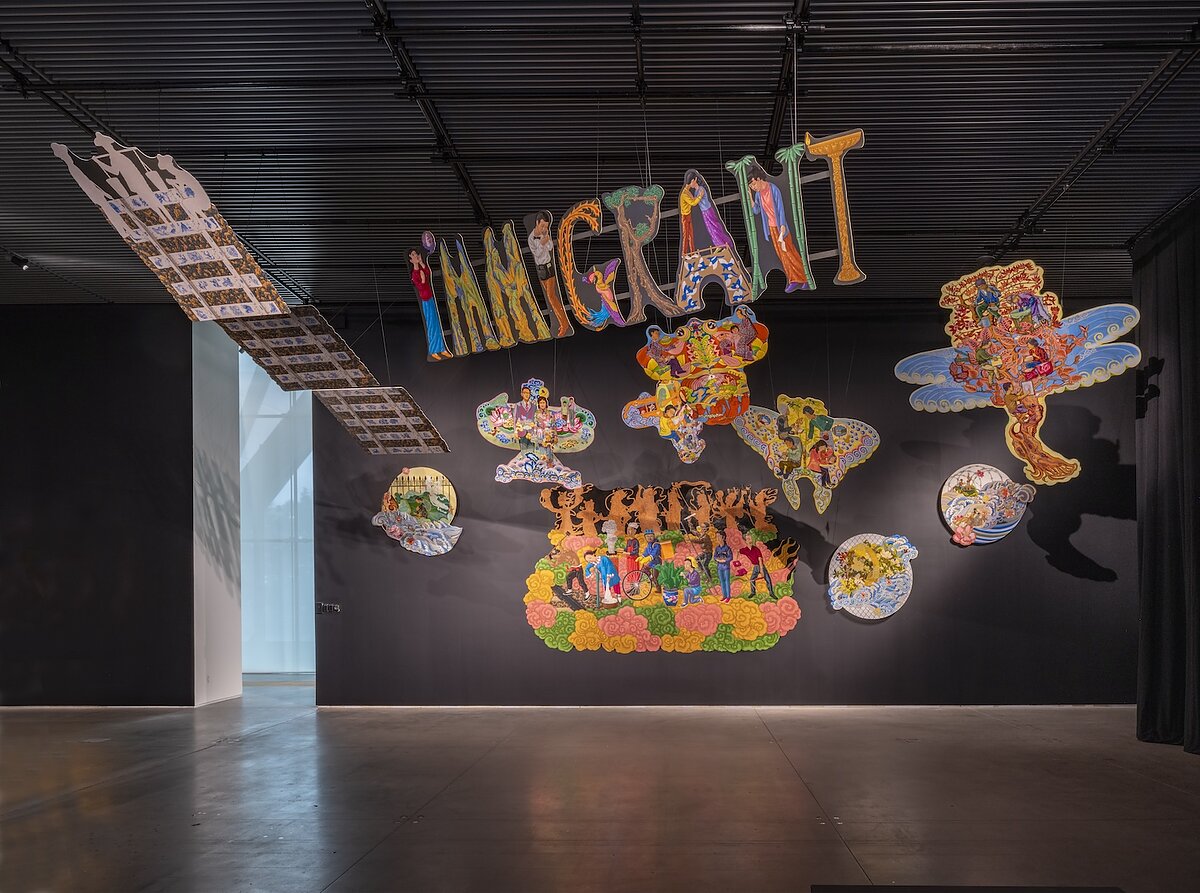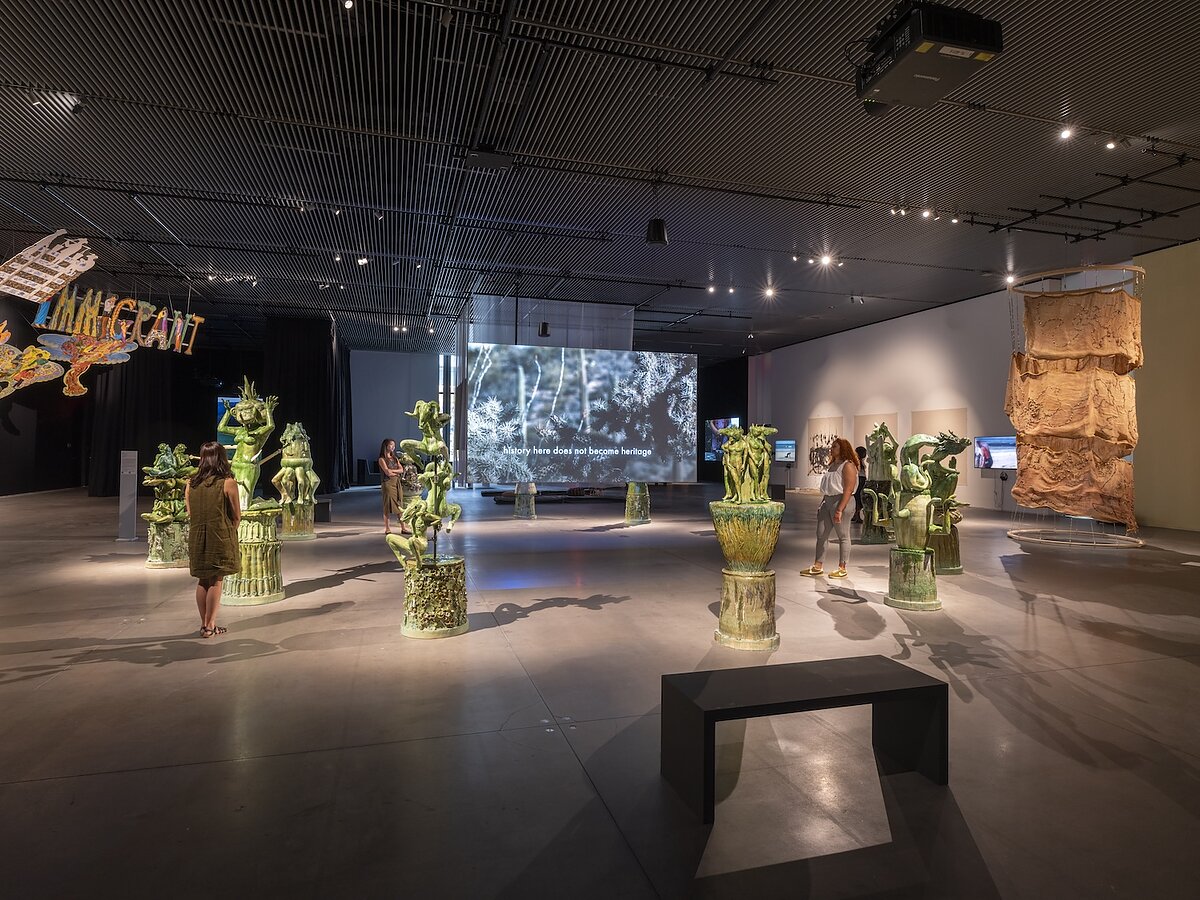AAPI Artists Reinterpreting Tradition at The Shed’s “Open Call: Portals”
At The Shed’s fourth iteration of their annual program, “OPEN CALL: PORTALS” (on view through August 24), 12 NYC-based artists were commissioned to create works that would transport audiences into socio-political contexts across the globe. Exploring themes of migration, colonialism, ecology and spirituality, these pieces form a sacred space within the institution’s second floor gallery space—a balm for the current US political landscape that villanizes the non-white and non-US born.
Of these dozen artists featured, three identify as AAPI: duo Lily Honglei, Zain Alam, and collective AYDO. Curator Dejá Belardo shared how during the curation process, they were “struck by the blending of traditional and ancestral references along with contemporary representation” in the works of these artists.
In conversation with one another, these works prompted me to consider the role spirituality holds in our contemporary grappling with colonization, both in the US and abroad. These artists reinforced the role of looking back at my own ancestry to see how those who came before us moved forward in times of such inequality.
In Lily Honglei’s KITES: A Poem by an Immigrant, traditional Chinese kites and a railroad constructed of Mahjong tiles to pay homage to Chinese immigrants and New Yorkers past and present. “As part of the Qing Ming festival, or the Tomb-Sweeping Day, people wrote the names of their family members on kites and cut the strings when the kites flew high,” shared the Flushing-based duo. “The released kites would symbolically remove all the issues and troubles from the loved ones, blessing them with good energy from nature. The kites represented undying souls traveling between heaven and humanity.”
In addition to nature motifs, painted on each kite is a letter—collectively, they spell out the word “IMMIGRANT”. Closer examination reveals each letter to be either a body in motion, greenery, golden symbols of abundance, or combinations of the three. The kites making up the rest of the installation feature people at work: building, delivering food, caring for plants, and creating art. Others call back to ancestral images of families across time periods. A railroad made of mahjong tiles looms to the side, reminding audiences of the labor of Chinese immigrants in their construction.
While most of these illustrations are celebrations and memorialize Chinese American culture, there are two figures that offer a darker, sobering portal in the flag titled Bamboos on Kissena Blvd. One figure, a blonde woman in red, stands in front of DC’s Capitol Hill representing hardline anti-immigrant politicians. The other figure is a migrant lying under a blanket on Flushing’s Kissena Blvd in the cold winter.
“Each kite in this series has its unique title and context,” Lily Honglei explains. “These two images signify the challenges facing the immigrant community.” In the middle of the composition is a thriving bamboo tree with enormous roots, which hints at the underlying resilience of our immigrant communities in spite of the hardships.
Elsewhere in the exhibition, Zain Alam’s Meter & Light: Night, builds on the question at the center of much of the artist’s work: In what ways can sound convey the ineffable? The sound of a human voice is the only audio that ushers audiences through a three-screen journey of devotional Muslim life after sunset. Tucked away behind three large curtains that frame the screens, a prayer mat and cushions live at the center of the experience for audiences to sit.
Witnessing the piece, I found myself becoming hyper aware of this quiet, meditative space juxtaposed with the boisterous, crowded city that lives outside its walls. Through the work, we’re reminded that these places of stillness exist all around the city.
Alam shared that he was particularly inspired by the catacombs in Brooklyn’s Greenwood Cemetery. “The quality of light, damp coolness, and long reflections of sound in that cavernous tunnel of space played a significant part in bringing a stillness and serenity to our performances that really lets that moment in the piece sing,“ he said.
Developed during his residency at Recess Art in 2024, Meter & Light: Night expands an earlier work titled Meter & Light: Day (2023), which was exhibited in “Devoted: Religion in Asian American Art,” a group show curated by Asian American Arts Alliance’s Danielle Wu at the Elizabeth Foundation for the Arts in 2024. Beyond its life at The Shed’s “OPEN CALL: PORTALS,” Alam shared that future iterations of Meter & Light: Night will “reach towards larger timescales, or perhaps even smaller, more granular ones.”
In AYDO’s Border Ecologies, the creative collaboration between artists A young Yu and Nicholas Oh continues to combine their respective disciplines of performance, video, ceramic sculpture, and site-specific installation.
The piece features footage taken from the Korean Demilitarized Zone (DMZ) and the US–Mexico borderland. To gather footage in the DMZ, AYDO joined Seung Ho Kim, founder and director of DMZ Ecology Research Institute, on weekly ecological excursions and discreetly filmed in areas that exist beyond military checkpoints.
“While our work at the DMZ was grounded in field work, our engagement with the US–Mexico borderlands unfolded through research, working closely with ecological, historical, and archival-based sources,” said AYDO. “We examined how intensified surveillance, expanding border infrastructure, and enforcement patterns intersect with the region’s role as a vital ecological corridor, impacting seasonal water systems and biodiversity.”
Screened via a double-sided projector, the footage is accompanied by poignant statements regarding colonized and militarized land: “The border is a living organism pretending its neutral ground” and “Punctuate the land with guard posts, train guns aimed not just at each other, but at memory itself.” Surrounding the projected visuals are sculptures interpreting Eastern Zodiac symbols and finished in traditional Korean ceramic methods. These objects represent the spiritual connections that still exist amongst even the most militarized of locations.
“Each sculpture is engraved with imagery drawn from the ecologies of both borders—cacti, rivers, trees, flora, and fauna—interwoven with the Eastern elements of water, fire, earth, metal, and wood, ” shared AYDO.
Through their combination of field work and archival research, AYDO communicates the parallels between these two ecologies, both manmade and indigenous. “History must be managed, not mourned,” reads one line of text.
Upon visiting the different artist portals featured in the exhibition, I was able to reflect not only on the incredible mirrors that these AAPI artists lifted to my own family and community, but the solidarity across all backgrounds that is so necessary for our collective survival.
“OPEN CALL: PORTALS” is open to the public until August 24, 2025.
—Bri (she/her/hers) is an artist and administrator based in Brooklyn. She is committed to the dismantling of gatekeeping in arts and culture and uses her experience in community engagement and education to develop meaningful partnerships. She is the Education & Community Outreach Manager at Primary Stages, and has served in various administrative capacities at Dance/NYC, Pan Asian Repertory Theatre, National Queer Theater, JACK Arts, Theatre Communications Group and more. She has also written for publications such as JoySauce LADYGUNN, HowlRound, American Theater Magazine and is a staff writer at Mixed Asian Media.


